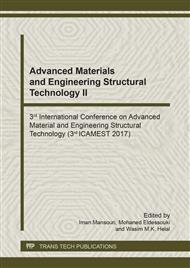p.106
p.112
p.117
p.123
p.129
p.134
p.140
p.146
p.154
Experimental Study on the Performance of Timber Frame Wall Panels in Mediterranean Construction
Abstract:
Only recently, the use of wooden buildings is spreading in the central and southern parts of the Italy due to national and EU policies on eco-sustainability and energy saving. Knowledge of the durability of the building envelope elements, generally made with dry assembled stratified systems, is still insufficient. The paper presents the first results of a durability evaluation of multilayer timber panel applied to Platform Frame System buildings, focusing on the variation of energy performance over time. The case study describes the construction of two single-family houses in the municipality of San Cataldo (Sicily, Italy). The used timber multilayer panel presents a stratigraphy suitable for climatic characteristics and is made of a lamellar spruce frame inside which rock wool insulation panels are laid and stiffened on both sides by OSB panels (Oriented Strand Board). The test methodology adopted is described in the ISO 15686 and based on the comparison between on-site monitoring data and data from laboratory tests of accelerated aging in climatic chamber. The selected parameters to be measured were: surface colour and thermal transmittance. The surface colour was also monitored during 2 years of exposition to natural agents, comparing the results to those of laboratory monitoring, thus obtaining the corresponding time rescaling for different facades, showing the best results for W, S and N ones. Theoretical thermal conductivity calculation was verified with laboratory data on representative samples of the real system by standardized methodology before accelerated aging. Thermal performance variations were assessed due to artificial aging inside climatic chamber, identifying the most deteriorating functional materials and layers and their influence on energy performance.
Info:
Periodical:
Pages:
146-153
Citation:
Online since:
March 2018
Authors:
Keywords:
Price:
Сopyright:
© 2018 Trans Tech Publications Ltd. All Rights Reserved
Share:
Citation:


